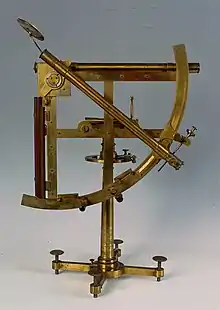
John Bird (1709–1776) was a British mathematical instrument maker. He was born at Bishop Auckland. He came to London in 1740 where he worked for Jonathan Sisson and George Graham.[1] By 1745 he had his own business in the Strand. Bird was commissioned to make a brass quadrant 8 feet across for the Royal Observatory at Greenwich, where it was mounted on 16 February 1750, and where it is still preserved. Soon after, duplicates were ordered for France, Spain and Russia. He was known for inventing the sextant[2][3]

John Bird | |
|---|---|
 Engraved portrait by V. Green. Credit: Wellcome Collection | |
| Born | 1709 |
| Died | 31 March 1776 |
| Occupation(s) | Inventor, Astronomer |
| Known for | Inventor of Sextant |
Bird supplied the astronomer James Bradley with further instruments of such quality that the commissioners of longitude paid him £500 (a huge sum) on condition that he take on an apprentice for 7 years and produce in writing upon oath, a full account of his working methods. This was the origin of Bird's two treatises The Method of Dividing Mathematical Instruments (1767) and The Method of Constructing Mural Quadrants (1768). Both had a foreword from the astronomer-royal Nevil Maskelyne. When the Houses of Parliament burned down in 1834, the standard yards of 1758 and 1760, both constructed by Bird, were destroyed.
Bird, with his fellow County Durham savant William Emerson, makes an appearance in Mason & Dixon, the acclaimed novel by Thomas Pynchon.
References
- ↑ The National Cyclopaedia of Useful Knowledge, Vol III, (1847) London, Charles Knight, p.327.
- ↑ Denham et al.,Leonard,McTighe,Shahanan, James M,M.C. Bob Leonard,Jay,Timothy (2014). United States Early Years. United States: McGraw-Hill Education. p. 83. ISBN 978-0-02-138478-5.
{{cite book}}: CS1 maint: multiple names: authors list (link) - ↑ "The History of the Sextant". www.mat.uc.pt. Retrieved 27 November 2023.
Further reading
- Bedini, Silvio (1970–1980). "Bird, John". Dictionary of Scientific Biography. Vol. 2. New York: Charles Scribner's Sons. pp. 140–141. ISBN 978-0-684-10114-9.